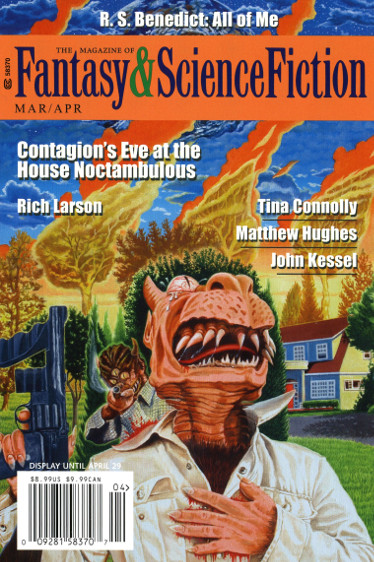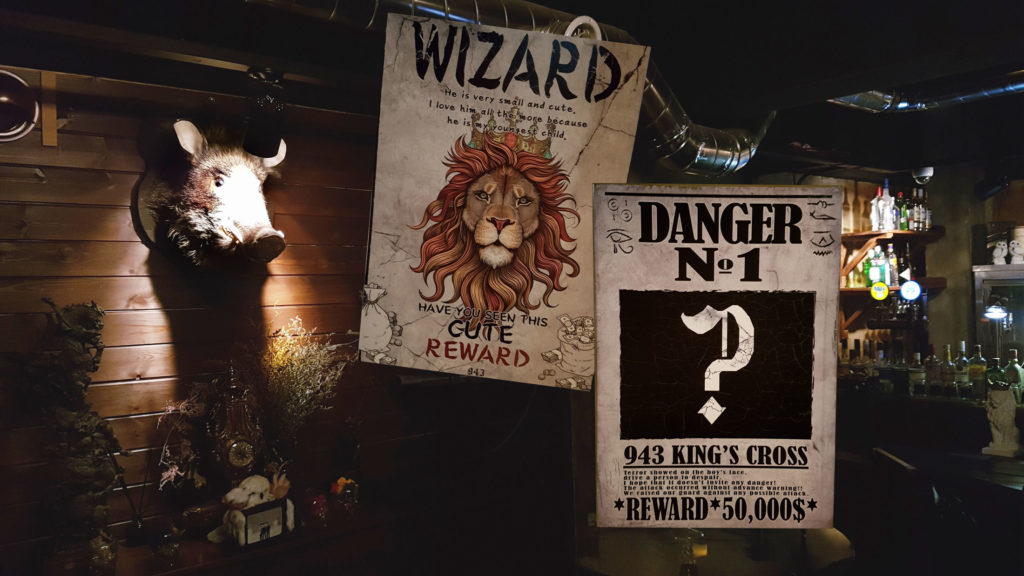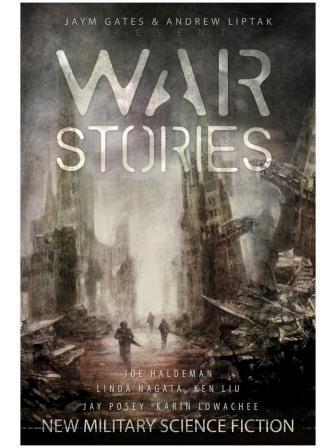(1) COVER REVEAL. Here is The Magazine of Fantasy & Science Fiction’s March/April 2019 cover. The cover art is by Kent Bash.

(2) BETTER WORLDS. The latest short story (and video adaptation) in The Verge’s “Better Worlds” series is “A Sun Will Always Sing,” by Karin Lowachee. (Video byYeah Haus.)
There’s also a Q&A: “Karin Lowachee on how humanity can peacefully coexist with AI” conducted by Andrew Liptak.
What inspired this story, and how did you construct this future?
I’d seen on YouTube a discussion from scientists about if an AI possessed an exact neural map of the human brain that it would not be out of the realm of possibility to believe that they would also be imbued with curiosity and maybe even a sense of responsibility for the Earth because now they, too, were a part of its systems. Around the same time, I stumbled on articles written by social scientists who believed that in taking care of certain economic necessities, humanity ideally could free up resources for creative problem-solving on the world scale and exploration.
These points of reference were really the general jumping-off points for me to try to logically extrapolate a human society that accommodated AIs (though not without some implied struggle) because the AIs were not, in fact, seeking a judgment day. They wanted to live and progress just as humans, and though their consciousness was not exact to humans, they were their own kind and just as worthy to be respected. We recognize this in intelligent animals, or even animals as a whole, so my thinking was it could be possible for AIs as well.
(3) WASTE NOT, WANT NOT. Max Florschutz offers advice about “Being a Better Writer: Garbage”. His ideas are far more realistic than J.K. Rowling’s.
Consider, for example, your trash. What happens to it? How do you dispose of it? Is it a garbage can next to your desk or in the kitchen? What happens to it once the can is full? Where does it go? Who deals with it? Do you know? Or does it simply “vanish?”
Well, here’s the thing. It definitely doesn’t vanish. Refuse is refuse: Someone has to do something with it or it piles up. Waste from your home, for example, at least in the US, is collected in a larger can and taken to the side of the road for a garbage truck to collect (99% of the time. The US’s coverage with this system is so ubiquitous that I’ve been to rural places where the only vehicle in town that isn’t a four-wheeler or a boat is the town garbage truck). That truck then takes it to a landfill or a processing center. At the first, the garbage is dumped out. At the second, it’s sorted and separated, usually with an end-goal in mind of dividing up the garbage into smaller, more dedicated end-states, from compost to recycling.
(4) NYRSF READINGS. Jim Freund asks, “Why waste your time with the State of the Union, when we have such a brilliant and more fulfilling alternative?”
The New York Review of Science Fiction Readings Series resumes Tuesday, February 5.

Mimi Mondal 
Karen Heuler
Mimi Mondal (Bone Stew) writes about history and politics, occasionally disguised as fiction. Her first co-edited anthology, Luminescent Threads: Connections to Octavia E. Butler won a Locus Award and was nominated for a Hugo Award in 2018. In the past Mimi has worked as an editor at Penguin India and Uncanny Magazine, and spent eleven years at universities in India, Scotland and the US, from which she is currently recovering in New York and at @Miminality on Twitter.
Karen Heuler’s stories have appeared in over 100 literary and speculative magazines and anthologies, from Conjunctions to Clarkesworld to Weird Tales, as well as a number of Best Of anthologies. She has received an O. Henry award, been a finalist for the Iowa short fiction award, the Bellwether award, the Shirley Jackson award for short fiction (twice), and others. She has published four novels and a novella, and her fourth story collection has just been published by Tartarus Press.
The events begins at 7:00 p.m. in The Brooklyn Commons Café, 388 Atlantic Avenue (between Hoyt & Bond St.) in Brooklyn, NY.
(5) FIVE STORIES IN ONE. Syfy Wire gets to Hogwarts by way of Korea: “Geek Road Trip: Harry Potter fans in South Korea just opened a five-story cafe devoted to the boy wizard”.

Once we get inside, we’re quickly pointed to the counter. The food and drink offerings here are relatively run-of-the-mill Seoul cafe classics: Americanos, various flavored lattes and milk teas, and fruity adeS. On the menu, they promise chocolate wands are coming soon, and on select days there’s Butterbeer. Dessert-wise there’s a selection of cakes, none of which are themed, save for one: the wizard cake, a mini replica of the birthday cake Hagrid brings to Harry. We ordered the wizard cake for a cool 17,000 Won (around $15), grabbed our pager, and began to explore.
And trust me, there’s a lot to explore. Everywhere you turn there’s a poster or a reference to something Harry Potter-esque. Quotes in English and Korean line the staircases along with posters and portraits. Even the elevator is fully decked out.
(6) NO CODE FOR THIS CONDUCT. The infosec industry conference DerbyCon is calling it quits after this year. Their explanation sounds like “We’re closing down rather than resorting to enforcing our code of conduct.”
Read their announcement here: “DerbyCon 9.0 – Every Beginning Has an End”.
…This year, we had to handle issues that honestly, as an adult, we would never expect to have to handle from other adults. Conferences in general have shifted focus to not upsetting individuals and having to police people’s beliefs, politics, and feelings. Instead of coming to a conference to learn and share, it’s about how loud of a message a person can make about a specific topic, regardless of who they tear down or attempt to destroy. To put it in perspective, we had to deal with an individual that was verbally and mentally abusive to a number of our volunteer staff and security to the point where they were in tears.
This is not what we signed up for.
Admittedly, we had no idea how to handle this person, and in fear of repercussion of removing this person, allowed them to stay at the conference in order to “not upset the masses”. The best we could do was just apologize, for other apologies, and apologize more for another’s actions. This is just one example of many we have had to deal with over the past few years, and each year it becomes increasingly harder for us to handle. We do everything as a conference to ensure the safety, security, and go above and beyond that of others. Maybe that puts us on a different level where something that would normally not be an issue explodes into a catastrophic situation on social media.
Who knows? What we do know is each year it gets harder and harder.
2019 will be our last year of DerbyCon.
Motherboard reports “Hackers Baselessly Blame Women and ‘SJWs’ for the End of DerbyCon Security Conference”.
…Some in the infosec community read the organizers’ statement and began to blame the shutdown on “Social Justice Warriors,” and women who complained too much. For example, far right blog Gateway Pundit pointed to an incident where an attendee complained that other attendees were joking about sexual assault outside of the conference’s Mental Health Village. Others on Twitter latched on to the rumor that “SJWs” killed DerbyCon.
Regardless of the reason for the conference’s cancellation, the announcement renewed a conversation about toxicity in the infosec community that has been taking place in earnest since at least 2017 (and in smaller circles before then), when the Verge reported on chat logs from well-known security researcher Morgan Marquis-Boire, in which he confessed to a series of sexual assaults; the Verge and VICE corroborated that reporting with multiple women who have knowledge of the assaults.
While some women in the cybersecurity world were discussing the toxic interactions, sexual harassment, and assaults they’ve faced in the infosec community, members of a popular closed Facebook hacking group called “illmob” began to attack women who have spoken up about these issues, including Georgia Weidman, a security researcher who recently tweeted that her career was hurt by attending and speaking at DerbyCon in 2013….
(7) TODAY’S BIRTHDAYS.
[Compiled by Cat Eldridge.]
- Born February 4, 1925 – Russell Hoban. Riddley Walker may well be one of the most difficult novels I’ve ever read but it’s certainly also worth it. ISFDB lists a lot of other SF works by him but I must say I hadn’t realised that he’d written any beyond this work. Had any of you known this? (Died 2011.)
- Born February 4, 1940 – John Schuck, 79. My favorite SF role by him is as the second Draal, Keeper of the Great Machine, on the Babylon 5 series. I know it was only two episodes but it was a fun role. He’s also played the role of Klingon ambassador Kamarag in Star Trek IV: The Voyage Home and in Star Trek VI: The Undiscovered Country. He guest starred in Deep Space Nine as Legate Parn In “The Maquis: Part II”, on Star Trek: Voyager as Chorus #3 in the “Muse” episode, and on Enterprise as Antaak in the “Divergence” and “Affliction” episodes. Oh, and he was Herman Munster in The Munsters Today. Now that was a silly role! Did you know his makeup was the Universal International Frankenstein-monster makeup format whose copyright NBCUniversal still owns?
- Born February 4, 1961 – Neal Asher, 58. I’ve been reading and enjoying his Polity series since he started it nearly twenty years ago. Listing all of his works here would drive OGH to a nervous tick as I think there’s now close to thirty works in total. I’m listening to The Line War right now and it’s typically filled with a mix of outrageous SF concepts (Dyson spheres in the middle of ten thousand year construction cycles) and humans who might not be human (Ian Cormac is back again). He’s the sort of writer that I think drives our Puppies to madness — literate pulp SF pumped out fast that readers like.
- Born February 4, 1970 – Gabrielle Anwar, 49. Currently Lady Tremaine on Once Upon a Time. On the BBC series Prince Caspian and the Voyage of the Dawn Treader, she once played Ramandu’s Daughter. Marti Malone in Body Snatchers which is the third film adaptation of that Finney novel. She was Queen Anne in The Three Musketeers which I love and Emily Davenport in The Librarian: Return to King Solomon’s Mines.
(8) COMICS SECTION.
- Patriotic Ewoks will shed a tear over this Brevity.
(9) STAR TREK: RENT. On The Late Late Show With James Corden, the cast of Star Trek: Discovery leaves the bridge for this week’s episode of Carpool Karaoke. Sing along with Sonequa Martin-Green, Anthony Rapp, Doug Jones and Mary Wiseman. Complete show is accessible through an Apple app.
There’s another preview on Twitter.
(10) WORLDCON ECONOMICS. Persistent Scribble tasks an unnamed author who feels the Worldcon should give them a free membership. Thread starts here.
(11) VAMPING IT UP. What We Do in the Shadows, from writer Jemaine Clement and director Taika Waititi, premieres March 27 on FX.
What We Do in the Shadows is a half-hour comedy series based on the feature film of the same name by co-creators Jemaine Clement and Taika Waititi. Set in New York City, the show follows three vampires who have been roommates for hundreds and hundreds of years. Stars Matt Berry, Kayvan Novak, Natasia Demetriou, Harvey Guillen and Mark Proksch.
(11) Y? Y NOT? The Hollywood Reporter has posted that, “‘Y: The Last Man’ Ordered to Series at FX.” Much of the cast had been announced as early as mid 2018 (The Hollywood Reporter: “‘Y: The Last Man’ FX Cast Unveiled, Diane Lane and Barry Keoghan to Star”), but FX has now definitized the series order.
File this under “years in the making.”
Brian K. Vaughan’s beloved comic series Y: The Last Man is finally coming to a screen. FX on Monday announced that it has picked up its TV adaptation to series. The network has handed out a series order for the drama from showrunner Michael Green and starring Barry Keoghan and Diane Lane. It is expected to premiere in 2020.
[…] Green (American Gods, Blade Runner 2049, Logan) and Aïda Mashaka Croal (Luke Cage, Turn) serve as showrunners and executive producers. Nina Jacobson and Brad Simpson of Color Force (American Crime Story, Pose, The Hunger Games) and Vaughan executive produce and developed the series. Melina Matsoukas (Insecure, Master of None, Beyonce: Formation) directed the pilot and exec produce the FX Productions drama. In addition to Keoghan and Lane, the cast also includes Amber Tamblyn, Imogen Poots, Lashana Lynch, Juliana Canfield and Marin Ireland.
(12) BLUER MARBLE. BBC story says “Climate change: Blue planet will get even bluer as Earth warms”.
Rising temperatures will change the colour of the world’s oceans, making them more blue in the coming decades say scientists.
They found that increased heat will change the mixture of phytoplankton or tiny marine organisms in the seas, which absorb and reflect light.
Scientists say there will be less of them in the waters in the decades to come.
This will drive a colour change in more than 50% of the world’s seas by 2100.
(13) AS EASY AS A. Chip Hitchcock says BBC’s article “How easy will it be to build a Moon base” is an “interesting overview despite one huge error-of-fact.” (Can you spot it?)
How can astronauts build a lunar base if traditional building materials are too heavy to load into a rocket?
In 1975, three years after the final Apollo Moon landing, Space: 1999 first aired on British television. It began with a nuclear explosion wrenching the Moon, and an international lunar colony of over 300 people, out of its orbit and into an unknown journey into space.
The TV series obviously made an impression on a young Elon Musk because, when the SpaceX founder revealed their plans for a lunar colony in August 2017, he called it Moonbase Alpha after the lunar base in Space: 1999. “Cheesy show,” Musk tweeted, “but I loved it.”
SpaceX is not alone is wanting to get humans back on the Moon. The Chinese space agency CNSA (China National Space Administration) has announced the next stages of its successful Chang’e lunar exploration missions – shortly after Chang’e 4 became the first spacecraft to make a soft landing on the far side of the Moon.
Chang’e 5 and 6 will be sample return missions while Chang’e 7 will survey the South Pole, a region of specific interest for human habitation because it contains water ice. “We hope that Chang’e 8 will help test some technologies and do some exploring,” deputy head of the CNSA Wu Yanhua said in January, “for the building of a joint lunar base shared by multiple countries.”
China is not alone in this ambition. Across the globe, 50 years after the Moon landings, the practicalities of a moonbase are taking shape. The irony is that, while only the United States of America has left footprints on the Moon, the Americans are now having to play catch up. It didn’t unveil plans for a permanent moonbase until August 2018. Nasa’s primary focus until then had been Mars. The European Space Agency (Esa) was already one step ahead.
(14) YARN V. GLASS CEILING. Pixar has a new short film that blurs the line between genre and a workplace dramedy (Mashable: “Pixar’s newest short ‘Purl’ is a must-watch for every workplace”).
Pixar’s new animation program SparkShorts has released its first short film, a powerful story about the difficulty of fitting into a workplace of human males.
“Purl” might be about a pink ball of yarn, but its title character adopts new behaviors and aggression to be one of the boys, a transparent allegory for women trying to break the glass ceiling in corporate culture.
[Thanks to Martin Morse Wooster, Gordon Van Gelder, Chip Hitchcock, Daniel Dern, Mike Kennedy, Errolwi, JJ, John King Tarpinian, Cat Eldridge, Carl Slaughter, and Andrew Porter for some of these stories. Title credit goes to ULTRAGOTHA.)


